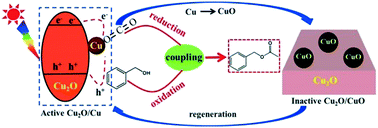当前位置:
X-MOL 学术
›
Catal. Sci. Technol.
›
论文详情
Our official English website, www.x-mol.net, welcomes your
feedback! (Note: you will need to create a separate account there.)
Coupling photocatalytic CO2 reduction with benzyl alcohol oxidation to produce benzyl acetate over Cu2O/Cu†
Catalysis Science & Technology ( IF 4.4 ) Pub Date : 2018-03-20 00:00:00 , DOI: 10.1039/c8cy00084k Yi Chen 1, 2, 3, 4, 5 , Mengtao Wang 1, 2, 3, 4, 5 , Yating Ma 1, 2, 3, 4, 5 , Yuanyuan Li 1, 2, 3, 4, 5 , Jingyu Cai 1, 2, 3, 4, 5 , Zhaohui Li 1, 2, 3, 4, 5
Catalysis Science & Technology ( IF 4.4 ) Pub Date : 2018-03-20 00:00:00 , DOI: 10.1039/c8cy00084k Yi Chen 1, 2, 3, 4, 5 , Mengtao Wang 1, 2, 3, 4, 5 , Yating Ma 1, 2, 3, 4, 5 , Yuanyuan Li 1, 2, 3, 4, 5 , Jingyu Cai 1, 2, 3, 4, 5 , Zhaohui Li 1, 2, 3, 4, 5
Affiliation

|
Photocatalytic reduction of CO2 to produce valuable chemicals can simultaneously reduce the greenhouse effect and relieve the energy shortage pressure. However, CO2 reduction over semiconductor-based photocatalysts usually generates C1 products. In this manuscript, we reported the preparation of a Cu2O/Cu nanocomposite for photocatalytic CO2 reduction under visible light. Since Cu2O has a narrow band gap, photocatalytic CO2 reduction over the as-obtained Cu2O/Cu was carried out in the presence of benzyl alcohol as the sacrificial agent to inhibit the possible oxidation of Cu+ by the photo-generated holes and to complete the photocatalytic cycle over Cu2O. It was found that benzyl acetate, instead of C1 products, was generated as the main product over Cu2O/Cu, which can be ascribed to a successful coupling of CO2 reduction and benzyl alcohol oxidation promoted by metallic Cu. After reaction, metallic Cu in Cu2O/Cu was oxidized to CuO, which led to the deactivation of the catalyst. However, the catalyst can be regenerated by reduction to recover its performance for producing benzyl acetate. The strategy by coupling photocatalytic CO2 reduction with the oxidation of organics not only can lead to valuable multi-carbon organics from CO2 reduction, but also can be used to inhibit the photo-corrosion of narrow-band gap semiconductor-based photocatalysts during photocatalytic reactions.
中文翻译:

在Cu 2 O / Cu † 上将光催化CO 2还原与苯甲醇氧化偶合以生成乙酸苄酯
光催化还原CO 2以产生有价值的化学物质可同时降低温室效应并缓解能源短缺压力。但是,与基于半导体的光催化剂相比,CO 2还原通常会生成C1产物。在这份手稿中,我们报道了在可见光下用于光催化还原CO 2的Cu 2 O / Cu纳米复合材料的制备。由于铜2 O具有一个窄的带隙,光催化CO 2还原在作为得到的Cu 2 O /铜在苄醇存在下作为牺牲剂进行抑制Cu的可能的氧化+通过光生空穴并完成在Cu 2 O上的光催化循环。发现在Cu 2 O / Cu上生成了乙酸苄酯而不是C1产物作为主要产物,这可以归因于成功的偶联。铜促进CO 2还原和苄醇氧化的机理 反应后,Cu 2 O / Cu中的金属Cu被氧化为CuO,导致催化剂失活。然而,可以通过还原来再生催化剂以恢复其生产乙酸苄酯的性能。通过将光催化还原CO 2与有机物氧化结合的策略不仅可以从CO 2中产生有价值的多碳有机物 还原,但也可用于抑制在光催化反应过程中窄带隙半导体基光催化剂的光腐蚀。
更新日期:2018-03-20
中文翻译:

在Cu 2 O / Cu † 上将光催化CO 2还原与苯甲醇氧化偶合以生成乙酸苄酯
光催化还原CO 2以产生有价值的化学物质可同时降低温室效应并缓解能源短缺压力。但是,与基于半导体的光催化剂相比,CO 2还原通常会生成C1产物。在这份手稿中,我们报道了在可见光下用于光催化还原CO 2的Cu 2 O / Cu纳米复合材料的制备。由于铜2 O具有一个窄的带隙,光催化CO 2还原在作为得到的Cu 2 O /铜在苄醇存在下作为牺牲剂进行抑制Cu的可能的氧化+通过光生空穴并完成在Cu 2 O上的光催化循环。发现在Cu 2 O / Cu上生成了乙酸苄酯而不是C1产物作为主要产物,这可以归因于成功的偶联。铜促进CO 2还原和苄醇氧化的机理 反应后,Cu 2 O / Cu中的金属Cu被氧化为CuO,导致催化剂失活。然而,可以通过还原来再生催化剂以恢复其生产乙酸苄酯的性能。通过将光催化还原CO 2与有机物氧化结合的策略不仅可以从CO 2中产生有价值的多碳有机物 还原,但也可用于抑制在光催化反应过程中窄带隙半导体基光催化剂的光腐蚀。











































 京公网安备 11010802027423号
京公网安备 11010802027423号